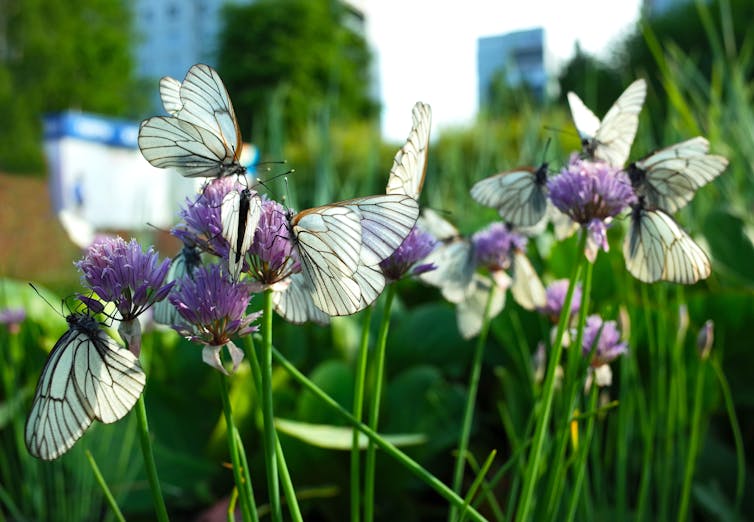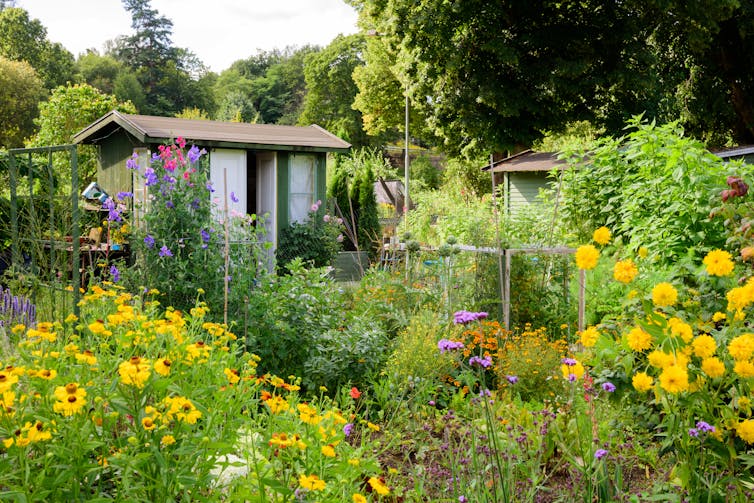
Pollinators such as bees, hoverflies and butterflies, are responsible for the reproduction of many flowering plants and help to produce more than three quarters of the world’s crop species. Globally, the value of the services provided by pollinators is estimated at between US$235 billion and US$577 billion.
It’s alarming, then, that pollinators are under threat from factors including more intense farming, climate change, disease and changing land use, such as urbanisation. Yet recent studies have suggested that urban areas could actually be beneficial, at least for some pollinators, as higher numbers of bee species have been recorded in UK towns and cities, compared with neighbouring farmland.
To find out which parts of towns and cities are better for bees and other pollinators, our research team carried out fieldwork in nine different types of land in four UK cities: Bristol, Reading, Leeds and Edinburgh.
An easy win
Urban areas are a complex mosaic of different land uses and habitats. We surveyed pollinators in allotments (also known as community gardens), cemeteries and churchyards, residential gardens, public parks, other green spaces (such as playing fields), nature reserves, road verges, pavements and man-made surfaces such as car parks or industrial estates.
Our results suggest that allotments are good places for bees and other pollinating insects, and that creating more allotments will benefit the pollinators in towns and cities. Allotments are beneficial for human health and well-being, and also help boost local food production.
In the UK, there are waiting lists for allotments in many areas, so local authorities and urban planners need to recognise that creating more allotment sites is a winning move, which will benefit people, pollinators and sustainable food production.
Good tips for green thumbs
We also recorded high numbers of pollinating insects in gardens. Residential gardens made up between a quarter and a third of the total area of the four cities we sampled, so they’re really a crucial habitat for bees and other pollinators in cities. That’s why urban planners and developers need to create new housing developments with gardens.But it’s not just the quantity of gardens that matters, it’s the quality, too. And there’s a lot that residents can do to ensure their gardens provide a good environment for pollinators.
Rather than paving, decking and neatly mown lawns, gardeners need to be planting flowers, shrubs and bushes that are good for pollinators. Choose plants that have plenty of pollen and nectar that is accessible to pollinators, and aim to have flowers throughout the year to provide a constant supply of food. Our research suggests that borage and lavender are particularly attractive for pollinators.

Often plants and seeds in garden centres are labelled with pollinator logos to help gardeners choose suitable varieties – although a recent study found that that ornamental plants on sale can contain pesticides that are harmful to pollinators, so gardeners should check this with retailers before buying.
Weeds are important too; our results suggest that dandelions, buttercups and brambles are important flowers for pollinators. So create more space for pollinators by mowing less often to allow flowers to grow, and leaving weedy corners, since undisturbed areas make good nesting sites.
An urban refuge
Parks, road verges and other green spaces make up around a third of cities, however our study found that they contain far fewer pollinators than gardens. Our results suggest that increasing the numbers of flowers in these areas, potentially by mowing less often, could have a real benefit for pollinators (and save money). There are already several initiatives underway to encourage local authorities to mow less often.
Ensuring there are healthy populations of pollinators will benefit the native plants and ecosystems in urban areas, as well as anyone who is growing food in their garden or allotment. Towns and cities could act as important refuges for pollinators in the wider landscape, especially since agricultural areas can be limited in terms of the habitat they provide.
It’s crucial for local authorities, urban planners, gardeners and land managers to do their bit to improve the way towns and cities are managed for pollinators. National pollinator strategies already exist for several countries, and local pollinator strategies and action plans are helping to bring together the key stakeholders in cities. Wider adoption of this type of united approach will help to improve towns and cities for both the people and pollinators that live there.
----------------------------------
This blog is written by Cabot Institute member Dr Katherine Baldock, NERC Knowledge Exchange Fellow, University of Bristol. This article is republished from The Conversation under a Creative Commons license. Read the original article.
 |
| Dr Katharine Baldock |
